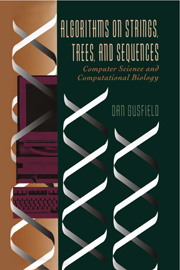Book contents
- Frontmatter
- Contents
- Preface
- I Exact String Matching: The Fundamental String Problem
- II Suffix Trees and Their Uses
- 5 Introduction to Suffix Trees
- 6 Linear-Time Construction of Suffix Trees
- 7 First Applications of Suffix Trees
- 8 Constant-Time Lowest Common Ancestor Retrieval
- 9 More Applications of Suffix Trees
- III Inexact Matching, Sequence Alignment, Dynamic Programming
- IV Currents, Cousins, and Cameos
- Epilogue – where next?
- Bibliography
- Glossary
- Index
6 - Linear-Time Construction of Suffix Trees
from II - Suffix Trees and Their Uses
Published online by Cambridge University Press: 23 June 2010
- Frontmatter
- Contents
- Preface
- I Exact String Matching: The Fundamental String Problem
- II Suffix Trees and Their Uses
- 5 Introduction to Suffix Trees
- 6 Linear-Time Construction of Suffix Trees
- 7 First Applications of Suffix Trees
- 8 Constant-Time Lowest Common Ancestor Retrieval
- 9 More Applications of Suffix Trees
- III Inexact Matching, Sequence Alignment, Dynamic Programming
- IV Currents, Cousins, and Cameos
- Epilogue – where next?
- Bibliography
- Glossary
- Index
Summary
We will present two methods for constructing suffix trees in detail, Ukkonen's method and Weiner's method. Weiner was the first to show that suffix trees can be built in linear time, and his method is presented both for its historical importance and for some different technical ideas that it contains. However, Ukkonen's method is equally fast and uses far less space (i.e., memory) in practice than Weiner's method. Hence Ukkonen is the method of choice for most problems requiring the construction of a suffix tree. We also believe that Ukkonen's method is easier to understand. Therefore, it will be presented first. A reader who wishes to study only one method is advised to concentrate on it. However, our development of Weiner's method does not depend on understanding Ukkonen's algorithm, and the two algorithms can be read independently (with one small shared section noted in the description of Weiner's method).
Ukkonen's linear-time suffix tree algorithm
Esko Ukkonen [438] devised a linear-time algorithm for constructing a suffix tree that may be the conceptually easiest linear-time construction algorithm. This algorithm has a space-saving improvement over Weiner's algorithm (which was achieved first in the development of McCreight's algorithm), and it has a certain “on-line” property that may be useful in some situations. We will describe that on-line property but emphasize that the main virtue of Ukkonen's algorithm is the simplicity of its description, proof, and time analysis.
- Type
- Chapter
- Information
- Algorithms on Strings, Trees, and SequencesComputer Science and Computational Biology, pp. 94 - 121Publisher: Cambridge University PressPrint publication year: 1997
- 2
- Cited by

